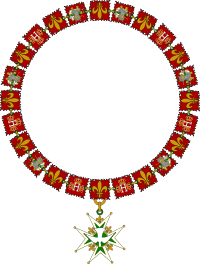Louis Marie Florent du Châtelet


Louis-Marie-Florent de Lomont d'Haraucourt, marquis later duc du Châtelet (20 November 1727, Semur-en-Auxois - 13 December 1793, Paris), was an aristocratic French Army general and diplomat of the Ancien Régime.
The Duke served as Governor of Semur-en-Auxois in Burgundy as well as Ambassador to the Court of St James's, besides other appointments. He was appointed to command the Regiment of French Guards shortly before the outbreak of the Revolution in 1789. Châtelet was subsequently imprisoned and guillotined, in 1793 aged 66.
Family
The son and heir of the noble and ancient Châtelet family, his mother, Émilie du Châtelet, famously was a scientist and the lover of Voltaire.[1]
On 20 June 1725, his father Florent-Claude du Chastelet married Gabrielle-Émilie, daughter of Louis Nicolas le Tonnelier de Breteuil. Like many marriages among the French nobility, theirs was an arranged marriage. The couple found they had little in common, but proprieties were observed in accordance with contemporary norms.
The Marquis and Marchioness produced three children: Françoise-Gabriel-Pauline (1726-1754), duchesse de Montenegro, Louis-Marie-Florent (later duc du Châtelet) and Victor-Esprit (born and died 1734).[2] After bearing three children, Émilie, marquise du Châtelet[3] considered her marital responsibilities fulfilled and reached an agreement with her husband to live separate lives while still maintaining one household.
Marriage

The Duke of Châtelet married, in 1752, Diane-Adélaïde de Rochechouart (died 1794) but they had no children. The Duke adopted his wife’s niece instead, also called Diane-Adélaïde, who was daughter of François-Jacques de Damas, marquis d'Antigny. She was born in Paris on 25 January 1761.
Having married, in 1777, Charles-François, comte de Simiane, thereby becoming styled Countess by courtesy, it soon became apparent that she had married a homosexual. Thereafter she sought comfort elsewhere with Gilbert du Motier, marquis de La Fayette who had served in the American Revolutionary War together with her husband (François, comte de Simiane died on 27 March 1787). The Duke also had an affair with her for the decade prior to his death in 1793. She never remarried and spent the remainder of her years at Château de Cirey, until her death (April 9, 1835).
Political role
In 1787 Châtelet was appointed to preside over the provincial assembly of the Ile-de-France, one of a number called to consider political and economic reform. The assembly consisted of representatives of all three recognized orders (clergy, nobility and bourgeois). They met in Melun on 11 July with Châtelet making the open address.
Military role
In 1788 the Duke took command as colonel of the Regiment of French Guards, "succeeding but not replacing" the respected Duke de Brion.[4] This elite unit of the Royal Military Household was permanently stationed in Paris and had many ties with the local population. Châtelet introduced "Prussian" codes of military discipline, which included harsh measures of physical punishment. At the same time he neglected to enforce greater professionalism amongst the aristocratic officer corps, who were often absent on leave and who left day-to-day administration of the regiment to its sergeants and corporals. As a result, morale amongst the rank and file weakened in the face of the increased disturbances in Paris during June–July 1789.
Revolution and death
On 12 July the unpopular Châtelet was recognized in a Paris street and pursued by a hostile crowd. He was rescued by a detachment of French Guards but two days later most of the regiment went over to the revolution, joining in the storming of the Bastille. Châtelet was subsequently arrested and, following a period in prison, guillotined on 13 December 1793.
Honours and titles
-
 Duc de France (Marquis before 1770)
Duc de France (Marquis before 1770) -
 Grand-croix, Ordre de Saint-Louis
Grand-croix, Ordre de Saint-Louis -
 Chevalier, Ordre de Malte
Chevalier, Ordre de Malte -
 Chevalier, Ordre du Saint-Esprit
Chevalier, Ordre du Saint-Esprit
See also
References
- ↑ www.visitvoltaire.com
- ↑ Hamel, Frank (1910). An Eighteenth Century Marquise: a study of Émilie du Châtelet and her times. London: Stanley Paul and Co. p. 25.
- ↑ www.wichita.edu
- ↑ Crowdy, Terry. French Revolutionary Infantry 1789-1802. p. 6. ISBN 1-84176-660-7.
Sources
- Hubert Saget Louis Marie Florent du Châtelet